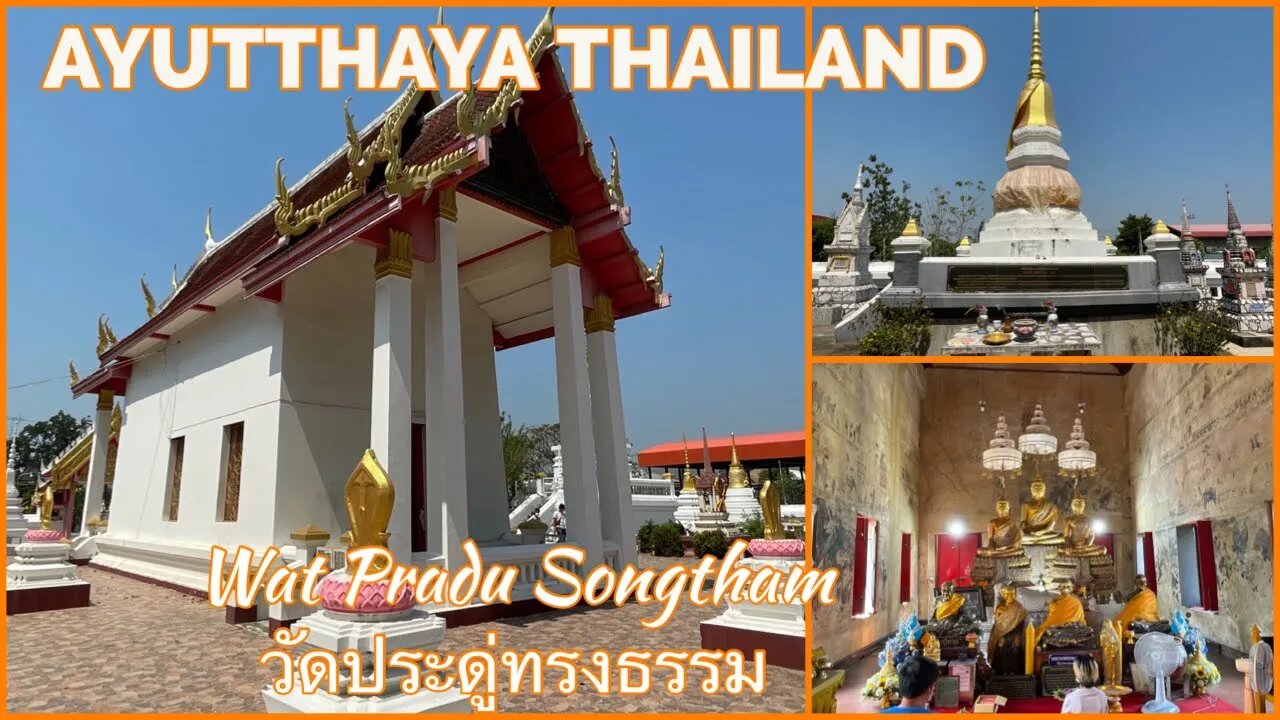Premium Only Content

Wat Pradu Songtham วัดประดู่ทรงธรรม - Historic Ayutthaya Temple - Thailand 2023
Wat Pradu Songtham วัดประดู่ทรงธรรม
This active monastery (Monastery of the Pradu Tree) is located off the city island in the northeastern part of the city.
Wat Pradu Songtham is situated in a part of the city known as Ayodhaya. It is widely believed that an ancient settlement existed here before King U-Thong established Ayutthaya in 1351.
As an active temple, Wat Pradu Songtham usual structures found at a
Buddhist monastery. A sermon hall, bell tower,and monk’s quarters are in situ. Most of
these are designed in a style reflecting the Bangkok period. The one structure that is missing is a chedi. It is assumed to have been destroyed over the years. The central feature of this monastery is its mural-decorated ordination hall.
The murals at Wat Pradu Songtham were painted in 1863. These have greatly deteriorated, but they still provide remarkable images of the lives of Buddha (Jataka) and Siamese culture during the Ayutthaya period. Scenes graphically depict Chinese acrobats, tightrope walkers, ascetics sleeping on a bed of knives, sinners being tortured, and the fashions during the Ayutthaya period. However, the most remarkable murals in the ordination hall are the ones portraying Royal processions with a large number of elephants. Derick Garnier points out that murals at Wat Pradu Songtham probably show the delivery of robes to the clergy during the Kathin ceremony, and that King Uthumphon most likely presented robes to monks at this monastery since he had
ordained here.
In 1985, the Muang Boran Publishing House released an entire book about the murals at
Wat Pradu Songtham and Wat Yom (a nearby monastery).
The National Museum of Thailand, located in Bangkok, has an ancient Buddha image on
display that was taken from this monastery. The exquisitely carved sandstone image dates to the 9th-10th century Dvaravati Period.
Wat Pradu Songtham played an important role in the city’s history. Royal Chronicles first
mention it in context of a rebellion by Japanese merchants in Ayutthaya. Many Japanese boats had started to conduct trade in the city, and these merchants were angered by their treatment once King Songtham took the throne in 1610, especially after the King ordered the execution of one of their leaders. About 500 Japanese joined with Phra Phimon and marched to the imperial place to kill the newly crowned king. However, eight holy monks from the Monastery of the Pradu Tree rescued the king and escorted him away from the Japanese. The Japanese were then attacked by Phra Maha Ammat, the future King Prasat Thong, and his troops. Many were killed before they could board their junks and flee the city. Wat Pradu Songtham was formally recognized by Royal patronage, which continued into the next dynasty.
Wat Pradu Songtham is also mentioned in the Royal Chronicles in relation to an important event occurring in 1758. When King Borommakot died earlier that year, a violent conflict ignited over who would be next in line to the throne. King Uthumphon eventually seized the crown, which caused many to fear that a civil war might erupt. Five revered high-ranking monks tried to avert the Kingdom’s political division by pressing for a peaceful solution at a site within the Royal Palace. As a result, King Uthumphon abdicated the throne to enter the monkhood at Wat Pradu Songtham only reigning for a total of ten days. His brother was then crowned King Suriyamarin (Ekathat).
While Uthumphon was still a monk at Wat Pradu Songtham, a rebellion was planned by
Prince Krom Mun Thepphiphit and four nobles They went to this monastery, prostrated themselves to Uthumphon, and informed him of their plans. The next day Uthumphon visited his brother and warned him of the upcoming rebellion and asked that the rebels lives be spared.
Taking advantage of Siam’s political chaos, Burmese armies invaded Siam once again
and Ayutthaya was forced to prepare for war.
As Burmese troops moved closer to the capital city nobles and citizens tried to persuade him to leave monkhood in order to protect the city. They wrote pleading messages, wrapped them up, and placed them in his alms bowls. Despite receiving a great number of messages each day, the former King decided to remain a monk. Burmese armies eventually conquered Ayutthaya on April 7, 1767, and destroyed the city. King Suriyamarin died in the process. The Burmese defrocked Uthumphon and he became a common layman. He was then shackled and led over the hills to Burma, where he ended his days recounting the past glories of the Kings of Ayutthaya.
Enjoy the video!
You can also see my videos on Rumble, Bitchute, Odysee and Subscribe Star. If you wish to contact me directly with a question or comment send me an email to [email protected]
#endlessjourney
#thailand
#travel
-
 11:41
11:41
Endless Journey
1 day agoBinbirdirek Cistern: Istanbul’s Underground Marvel - 4th Century Roman Cistern - Turkey 2025
9 -
 30:40
30:40
Tucker Carlson
12 hours agoThe 9/11 Files: From Cover-up to Conspiracy | Ep 4
42.6K23 -
 LIVE
LIVE
The Chris Salcedo Show
12 hours agoAfter What They've Done, Mockery Is The Best They Deserve
665 watching -
 2:57:12
2:57:12
TimcastIRL
13 hours agoDems SHUTDOWN Government For NO KINGS Insurrection, Block Police Pay | Timcast IRL
501K160 -
 12:35
12:35
Adam Something
4 days agoTesla Cybertruck: A Tragedy On Four Wheels
11.6K9 -
 8:22
8:22
Silver Dragons
19 hours agoAre Silver Rounds Really the BEST SILVER to Stack Right Now?
9.18K11 -
 19:52
19:52
Neil McCoy-Ward
20 hours ago🚨 The Global Financial Collapse May Have Already Started 🔥
10.9K4 -

BEK TV
23 hours agoTrent Loos in the Morning - 10/14/2025
9.73K1 -
 10:12
10:12
Ken LaCorte: Elephants in Rooms
18 hours ago $0.91 earnedIt's not just about intelligence
10.5K6 -
 1:43
1:43
NAG Daily
15 hours agoNEWS HEADLINES FOR DUMMIES W/GREENMAN REPORTS
8.64K2